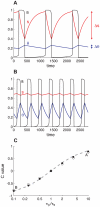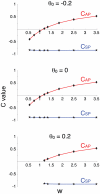Quantifying the relative contributions of divisive and subtractive feedback to rhythm generation
- PMID: 21533065
- PMCID: PMC3080843
- DOI: 10.1371/journal.pcbi.1001124
Quantifying the relative contributions of divisive and subtractive feedback to rhythm generation
Abstract
Biological systems are characterized by a high number of interacting components. Determining the role of each component is difficult, addressed here in the context of biological oscillations. Rhythmic behavior can result from the interplay of positive feedback that promotes bistability between high and low activity, and slow negative feedback that switches the system between the high and low activity states. Many biological oscillators include two types of negative feedback processes: divisive (decreases the gain of the positive feedback loop) and subtractive (increases the input threshold) that both contribute to slowly move the system between the high- and low-activity states. Can we determine the relative contribution of each type of negative feedback process to the rhythmic activity? Does one dominate? Do they control the active and silent phase equally? To answer these questions we use a neural network model with excitatory coupling, regulated by synaptic depression (divisive) and cellular adaptation (subtractive feedback). We first attempt to apply standard experimental methodologies: either passive observation to correlate the variations of a variable of interest to system behavior, or deletion of a component to establish whether a component is critical for the system. We find that these two strategies can lead to contradictory conclusions, and at best their interpretive power is limited. We instead develop a computational measure of the contribution of a process, by evaluating the sensitivity of the active (high activity) and silent (low activity) phase durations to the time constant of the process. The measure shows that both processes control the active phase, in proportion to their speed and relative weight. However, only the subtractive process plays a major role in setting the duration of the silent phase. This computational method can be used to analyze the role of negative feedback processes in a wide range of biological rhythms.
Conflict of interest statement
The authors have declared that no competing interests exist.
Figures








Similar articles
-
Differential control of active and silent phases in relaxation models of neuronal rhythms.J Comput Neurosci. 2006 Dec;21(3):307-28. doi: 10.1007/s10827-006-8862-7. Epub 2006 Jul 28. J Comput Neurosci. 2006. PMID: 16896520
-
Determining the contributions of divisive and subtractive feedback in the Hodgkin-Huxley model.J Comput Neurosci. 2014 Dec;37(3):403-15. doi: 10.1007/s10827-014-0511-y. Epub 2014 Jun 25. J Comput Neurosci. 2014. PMID: 24962951
-
Gain control with A-type potassium current: IA as a switch between divisive and subtractive inhibition.PLoS Comput Biol. 2018 Jul 9;14(7):e1006292. doi: 10.1371/journal.pcbi.1006292. eCollection 2018 Jul. PLoS Comput Biol. 2018. PMID: 29985917 Free PMC article.
-
Folic acid supplementation and malaria susceptibility and severity among people taking antifolate antimalarial drugs in endemic areas.Cochrane Database Syst Rev. 2022 Feb 1;2(2022):CD014217. doi: 10.1002/14651858.CD014217. Cochrane Database Syst Rev. 2022. PMID: 36321557 Free PMC article.
-
Mammalian circadian signaling networks and therapeutic targets.Nat Chem Biol. 2007 Oct;3(10):630-9. doi: 10.1038/nchembio.2007.37. Nat Chem Biol. 2007. PMID: 17876320 Review.
Cited by
-
Entrainment to periodic initiation and transition rates in a computational model for gene translation.PLoS One. 2014 May 6;9(5):e96039. doi: 10.1371/journal.pone.0096039. eCollection 2014. PLoS One. 2014. PMID: 24800863 Free PMC article.
-
Sub- and suprathreshold adaptation currents have opposite effects on frequency tuning.J Physiol. 2012 Oct 1;590(19):4839-58. doi: 10.1113/jphysiol.2012.234401. Epub 2012 Jun 25. J Physiol. 2012. PMID: 22733663 Free PMC article.
-
A cortical attractor network with Martinotti cells driven by facilitating synapses.PLoS One. 2012;7(4):e30752. doi: 10.1371/journal.pone.0030752. Epub 2012 Apr 16. PLoS One. 2012. PMID: 22523533 Free PMC article.
-
UP-DOWN cortical dynamics reflect state transitions in a bistable network.Elife. 2017 Aug 4;6:e22425. doi: 10.7554/eLife.22425. Elife. 2017. PMID: 28826485 Free PMC article.
-
Slow negative feedback enhances robustness of square-wave bursting.J Comput Neurosci. 2023 May;51(2):239-261. doi: 10.1007/s10827-023-00846-y. Epub 2023 Apr 17. J Comput Neurosci. 2023. PMID: 37067661 Free PMC article.
References
-
- van der Pol B, van der Mark J. The heartbeat considered as a relaxation oscillation, and an electrical model of the heart. Phil Mag. 1928;6:763–775.
-
- Rinzel J, Ermentrout B. Analysis of neural excitability and oscillations. In: Koch C, Segev I, editors. Methods in Neuronal Modeling: From Synapses to Networks. Cambridge, MA: MIT Press; 1989.
Publication types
MeSH terms
Grants and funding
LinkOut - more resources
Full Text Sources

